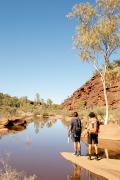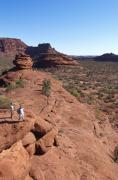Finke Gorge National Park
If you are interested in exploring the cultural landscape of the Western Arrarnta people, Finke Gorge National Park is a great place to do so. Explore the spectacular landscapes that inspired the renowned watercolourist Albert Namatjira, and others in the Hermannsburg school of painting, who were born and grew up at Hermannsburg Mission. Take a moment to sit at Palm Valley and imagine that you are in one of Gus Williams sing-alongs.
The park is managed by the Northern Territory Parks and Wildlife Service in partnership with the Traditional Owners. The ancient and majestic Finke River has deeply incised the Central Australian Ranges, giving rise to remarkable sandstone formations, varied ecosystems and a safe haven for relict species including the threatened Red Cabbage Palm, Livistona mariae. The Park is part of the traditional homelands of the Arrernte Aboriginal people, housing a number of important sacred sites and Dreamings that underpin local culture.
The Finke River contains some of the largest and most permanent waters in Central Australia, and it has sustained Arrarnta people and their ancestors during the most prolonged droughts. Known as Lhere Pirnte by the Arrarnta Traditional Owners, the river and its surrounds comprise a living landscape of cultural, spiritual and historical significance.
Finke Gorge National Park’s key values include an outstanding representation of Central Australian flora, a continued cultural connection to an ancient landscape and a tranquil destination for four-wheel drive enthusiasts. The Park features scenic palms, springs and rocky outcrops at Palm Valley and the permanent waters and historic Police Camp ruins at Boggy Hole.
Under the laws from the Tnengkerre or Dreaming, the Traditional Owners of Finke Gorge National Park are responsible for country and are obliged to maintain and protect it. To ensure country is properly cared for, they continue to pass information onto the next generation by “showing our ancestors’ history there, how to look after it.” They continue to hold ceremonies and attend meetings for spiritual and secular purposes relating to the area. Restricted ceremonies are occasionally held on important sites within the Park.
Traditional Owners have detailed knowledge of bush foods and medicines including where and when to find them, and how to use them. Hunting and gathering are important activities for maintaining connection to country and passing knowledge on to the next generation. Traditional Owners exercise their right to hunt wildlife and gather bush foods and medicine in accordance with Aboriginal tradition, and as permitted under the Territory Parks and Wildlife Conservation Act, 1976.
Pre and Post-contact Sites
Aboriginal sites from before and after the arrival of Europeans are all important parts of the heritage of the Western Arrarnta people. These places are part of the cultural landscape and many are significant to both Indigenous and non-Indigenous Australians. They are tangible reminders of the continuity and change Traditional Owners and their country have endured. Many sites in the area are not open to the general public due to their cultural sensitivity. The Park contains many places of spiritual significance and a number of dreaming trails traverse the country, linking the area culturally to places far away. A number of sacred sites have been recorded in the Park and are protected under the Northern Territory Aboriginal Sacred Sites Act. However, there are some places in Finke River National Park where the observant visitor can see Aboriginal sites.
- Aboriginal Occupation Sites - Numerous occupation sites occur along the Finke River, consistent with it being a major trade and travel route for the central ranges and western desert Aboriginal people. The large permanent waterhole at Boggy Hole (Litharra) is particularly significant.
- Several rock painting and engraving sites are located throughout the Park. Archaeological evidence at the upper Finke River catchment indicates approximately 30,000 years of occupation, with more intensive use of resources occurring in the last 1,000 years.
- Boggy Hole Police Camp - Established in 1889 by Constable Willshire to "pacify" suspected cattle killers, this site has an infamous association with repression of local Aboriginal people. The stone ruin is on the Register of the National Estate and may, in the future, be listed on the NT Heritage Register for its significant heritage value.
- Cocky’s Camp - A timber post and rail cattle yard associated with early pastoral activity on what was once Henbury Station. Known as Cocky's Camp, this site in the south-east of the Park is seldom visited, but potentially offers good interpretive material for visitors.
- Bonds Tours Campground - Established in 1933, Bonds Tours were the first commercial tours to bring visitors from the Finke River Mission Station (Hermannsburg) to a camp on Palm Creek. Gus Williams of Hermannsburg used to host singalongs at the camp for the visitors. Several huts were erected on the site in the early 1950’s. All structures were eventually removed in 1976 and the Palm Valley campground now occupies the original site.
For up to date information about the Finke Gorge National Park.
Media





